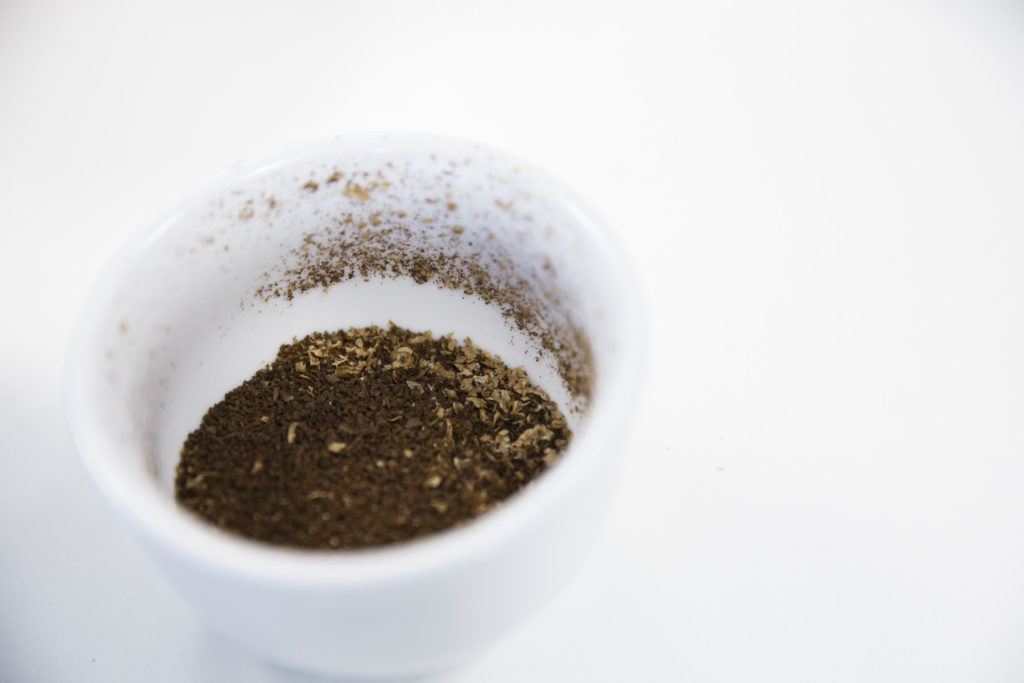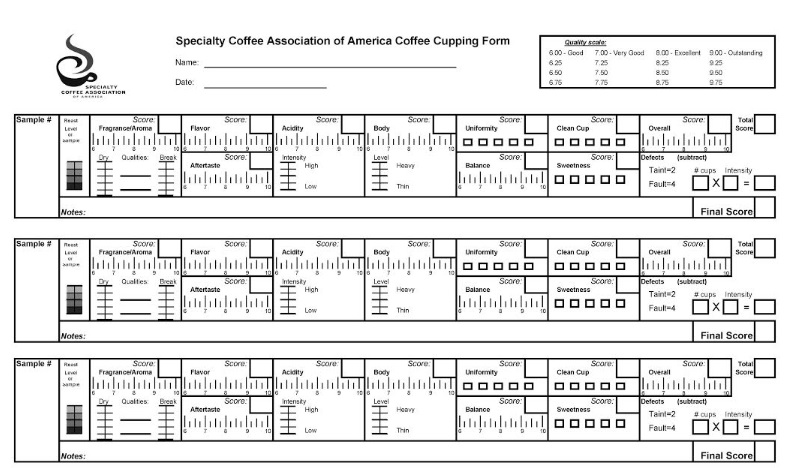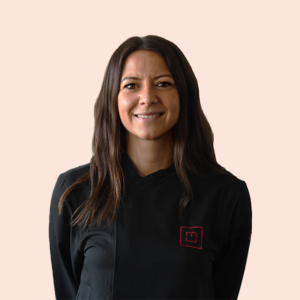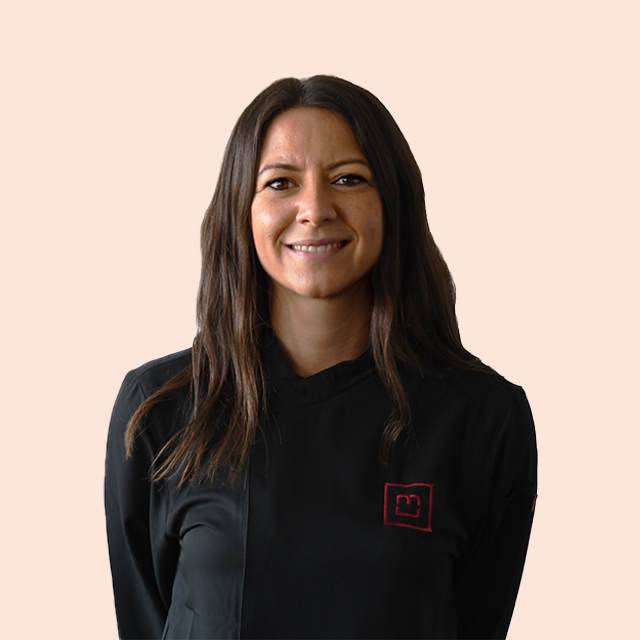
The SCA scoring protocol was created at the same time as the Specialty Coffee Association of America, in 1982. The main objective of the protocol was to separate specialty coffee from commercial or conventional coffee .
The maximum possible valuation for this protocol is 100 points and it is considered from 80 points onwards the borderline at which we classify a coffee as special.
How do we prepare for the appraisal?
To evaluate the coffees with maximum attention, it is recommended to prepare a table with 6-9 samples for a cupping session. The total duration time is 45 minutes from the time the water is poured until the SCA protocol is completed. During this period of time the cupper has to evaluate how the characteristics of the coffee evolve at three temperatures: hot, warm and room temperature.
This is the material we need to prepare our tasting table:
- Utensils: We will need 5 cups per sample (the volume of each cup should be 200-260 ml), spoons, glasses with water, glasses to clean the spoons, spit cups, napkins, codes to mark each sample and a stopwatch.
- Coffee: We will prepare a light roast (60-60 for Agtron or Probat 90-105 Colorette).
- Water: Temperature +/-93, ppm-75-250 and ph-6.5.
Steps for the preparation of the tasting
Once we have all the necessary material ready, we start to set up the tasting table, these are the steps to follow:
- We weigh the coffee, depending on the volume of the cup – 5.5-6 (+/-0.1) grams of coffee per 100ml. of water.
- We grind the coffee in each cup separately. By purging the mill between samples using a small amount of the same coffee, the grinding point is medium coarse (70% sample – 850mµ).
- Prepare the table by placing a glass of hot water and a napkin near each sample.
- We provide each taster with a spit cup and the SCA scoring form.
- Once we have prepared the table with ground coffee, we do not touch the cups anymore.
It is important and advisable that the people who are going to taste the coffees do not wear perfume so as not to contaminate the odors.
Steps for the evaluation of coffees
- We analyze the intensity of roasting: we note whether some samples are darker or lighter in color than others.
- We analyze the fragrance, the dry scent: we note the intensity and descriptors.
- Pour the water, with the same speed and height as uniformly as possible. We wait 4 minutes
- We analyze the aroma of the crust, without touching it, and note down the descriptors
- We “break” the crust, touching only the surface, without going down to the bottom of the cup as evenly as possible. Between cups, we pass the spoon through the nearest glass of hot water, so as not to contaminate the possible defects between cups. We analyze the aroma, note intensity and descriptors
- When the aroma is analyzed, we clean the surface with 2 spoons.
- We can start tasting between minute 10 and 12 from the beginning of the infusion, when the temperature reaches about 60 degrees.
- We make a first round of calibration, we try all the cups on the table without evaluating, but noting if there are any doubts about the uniformity or cleanliness of some cups, it is also a good time to note some descriptors that attract more attention.
- With the second pass (the temperature of the coffee will be close to 50 degrees) we can write down the descriptors of the coffee. We begin to evaluate the characteristics, marking the scales but not yet putting the scores. Here we have to finish evaluating the uniformity, cleanliness and sweetness of the coffee, we also note the intensity and type of possible defect found.
- With the third pass (the temperature is already close to 40 degrees) we have to see how the characteristics of the coffee evolve. Arrows indicate whether the score is increasing or decreasing.
- With the fourth pass (the temperature is close to 30 degrees) we have to finish with the evaluation, the description and the scores of all attributes.

How is the assessment in the SCA protocol sheet performed?
These are the positive quality scores for each of the attributes and the points they add up to within the SCA protocol:
AromaScore on a scale of 0.25 with a maximum of 10 points. Takes into account intensity and descriptors
Flavor: score on a scale of 0.25 with a maximum of 10 points. Takes into account the descriptors
Aftertaste: score on a scale of 0.25 with a maximum of 10 points. Takes into account the intensity and quality
Acidity: score on a scale of 0.25 with a maximum of 10 points. Takes into account the intensity and type
Body: score on a scale of 0.25 with a maximum of 10 points. Takes into account the intensity
Balance sheet: score on a scale of 0.25 with a maximum of 10 points.
Cleanliness: score on a 2-point scale with a maximum of 10 points.
Sweetness: score on a 2-point scale with a maximum of 10 points
Uniformity: score on a scale of 2 points with a maximum of 10 points
General: score on a scale of 0.25 with a maximum of 10 points
How are defects evaluated?
Defects, on the other hand, are negative scores. A defect is a problem in the cup that can be caused by phenol, ferment, fungus, chemical stains or other types of stains that we can clearly name and that diminish both the quality and cleanliness of the cup.
– Defect intensities are classified as follows:
- Defective stain: 2 points, it is possible to name the defect that lowers the quality and cleanliness but allows to value the attributes of the coffee.
- Strong defect: 4 points, this defect seriously damages the quality and cleanliness of the cup, in addition it does not allow to see or evaluate other characteristics of the coffee.
The intensity of the defect found is multiplied by the number of cups containing the defect and the result is subtracted from the final score .
Once the cupping is finished, the last 5-10 minutes are dedicated to filling out the SCA protocol sheets and calculating the final scores of the coffees on the table.
We hope to have answered some of your questions regarding the preparation of a tasting table and the operation of the SCA Protocol with this small guide. See you in the next Post!




